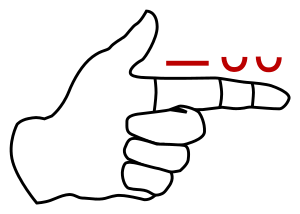Dactyl (poetry)
| Disyllables | |
|---|---|
| ˘ ˘ | pyrrhus, dibrach |
| ˘ ¯ | iamb |
| ¯ ˘ | trochee, choree |
| ¯ ¯ | spondee |
| Trisyllables | |
| ˘ ˘ ˘ | tribrach |
| ¯ ˘ ˘ | dactyl |
| ˘ ¯ ˘ | amphibrach |
| ˘ ˘ ¯ | anapaest, antidactylus |
| ˘ ¯ ¯ | bacchius |
| ¯ ¯ ˘ | antibacchius |
| ¯ ˘ ¯ | cretic, amphimacer |
| ¯ ¯ ¯ | molossus |
| See main article for tetrasyllables. | |
A dactyl (Greek: δάκτυλος, dáktylos, “finger”) is a foot in poetic meter. In quantitative verse, often used in Greek or Latin, a dactyl is a long syllable followed by two short syllables, as determined by syllable weight. In accentual verse, often used in English, it is a stressed syllable followed by two unstressed syllables—the opposite is the anapaest (two unstressed followed by a stressed syllable).
The Greek and Latin words δάκτυλος and dactylus are themselves dactyls (and hence autological). The English word poetry is also a dactyl. A useful mnemonic for remembering this long-short-short pattern is to consider the relative lengths of the three bones of a human finger: beginning at the knuckle, it is one long bone followed by two shorter ones (hence the name dactyl).
An example of dactylic meter is the first line of Henry Wadsworth Longfellow's poem Evangeline, which is in dactylic hexameter:
- This is the / forest prim- / eval. The / murmuring / pines and the / hem locks,
The first five feet of the line are dactyls; the sixth a trochee.
Stephen Fry quotes Robert Browning's The Lost Leader as an example of the use of dactylic metre to great effect, creating verse with "great rhythmic dash and drive":[1]
- Just for a handful of silver he left us
- Just for a riband to stick in his coat
The first three feet in both lines are dactyls.

Another example: the opening lines of Whitman's "Out of the Cradle Endlessly Rocking" (1859), his poem about the birth of his poetic voice:
- Out of the cradle, endlessly rocking [a dactyl, followed by a trochee ('cradle'); then another dactyl followed by a trochee ('rocking')]
- Out of the mockingbird's throat, the musical shuttle [2 dactyls, then a trochee ('throat, the'); then another dactyl, followed by a trochee]
- . . .
The dactyl "out of the..." becomes a pulse that rides through the entire poem, often generating the beginning of each new line, even though the poem as a whole, as is typical for Whitman, is extremely varied and "free" in its use of metrical feet.
Dactyls are the metrical foot of Greek elegiac poetry, which followed a line of dactylic hexameter with dactylic pentameter.
See also
References
- ↑ Stephen Fry (2006), The ode less travelled: unlocking the poet within, Gotham, p. 84, ISBN 978-1-59240-248-9